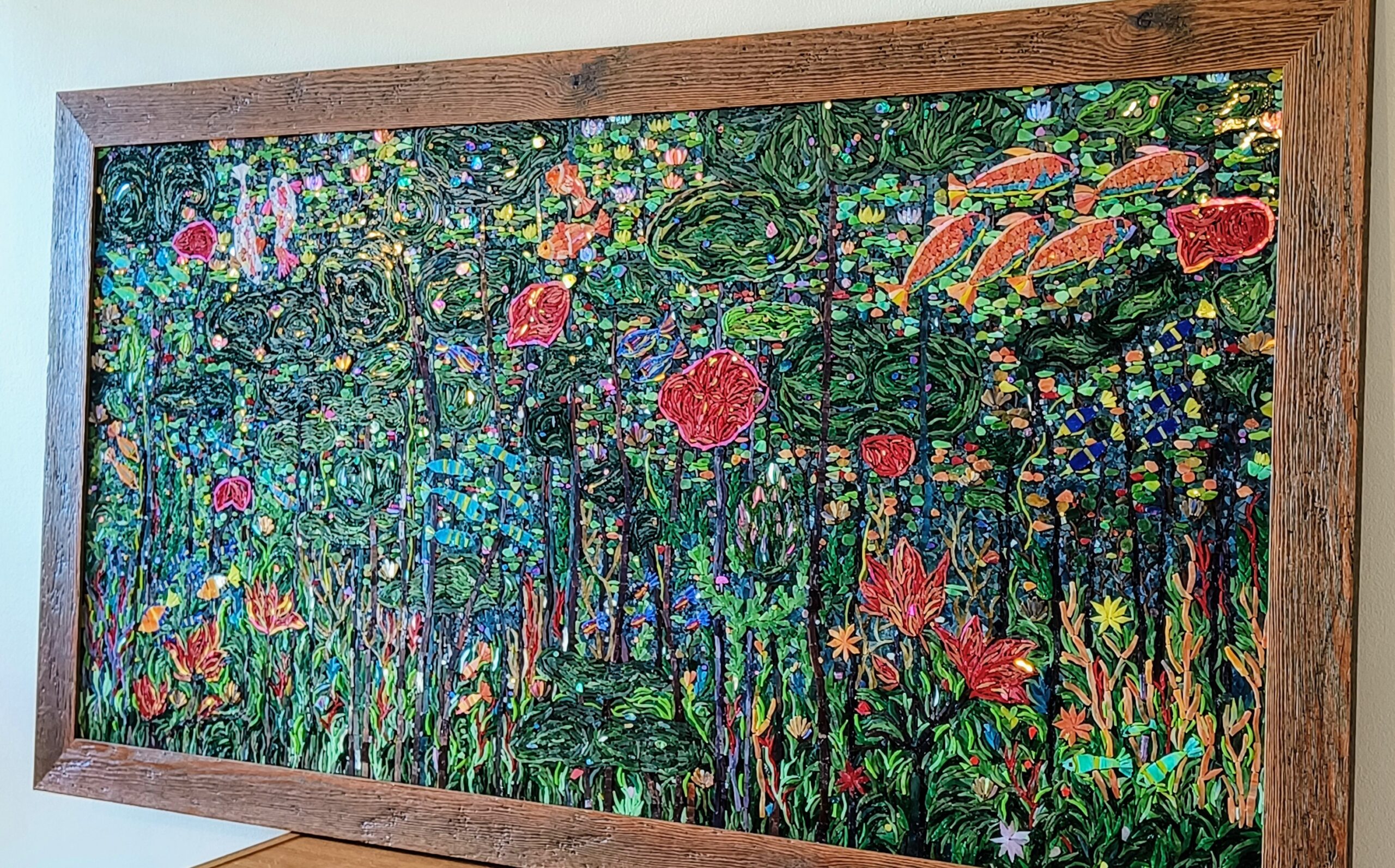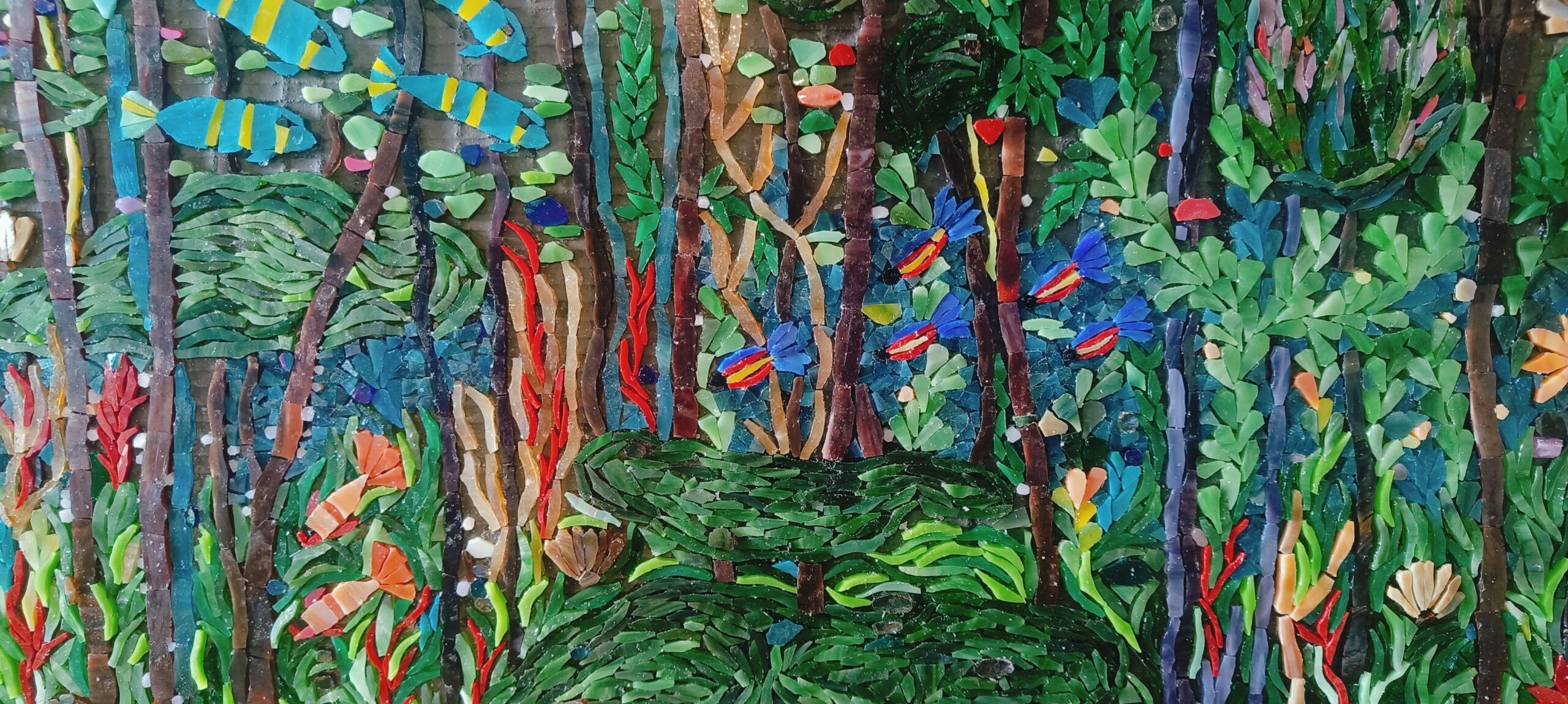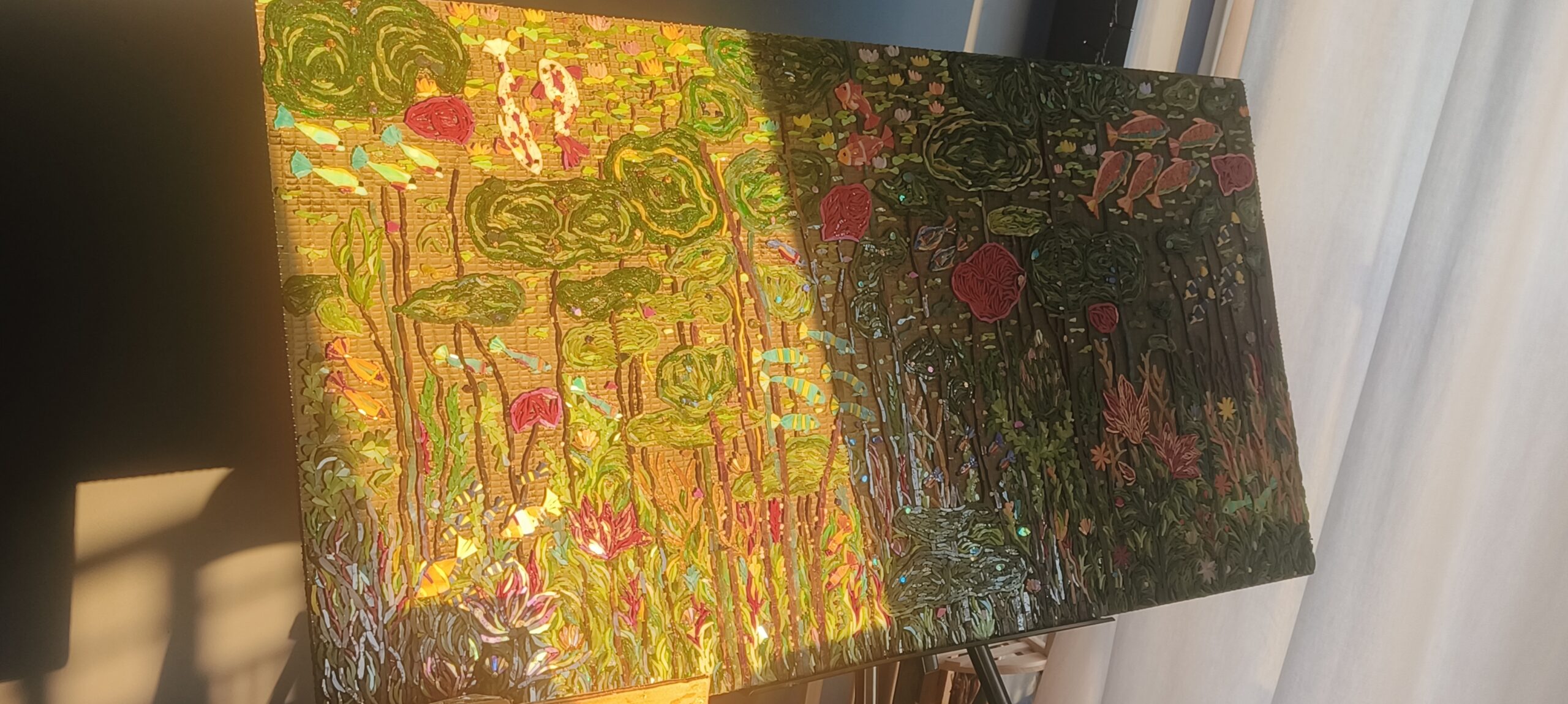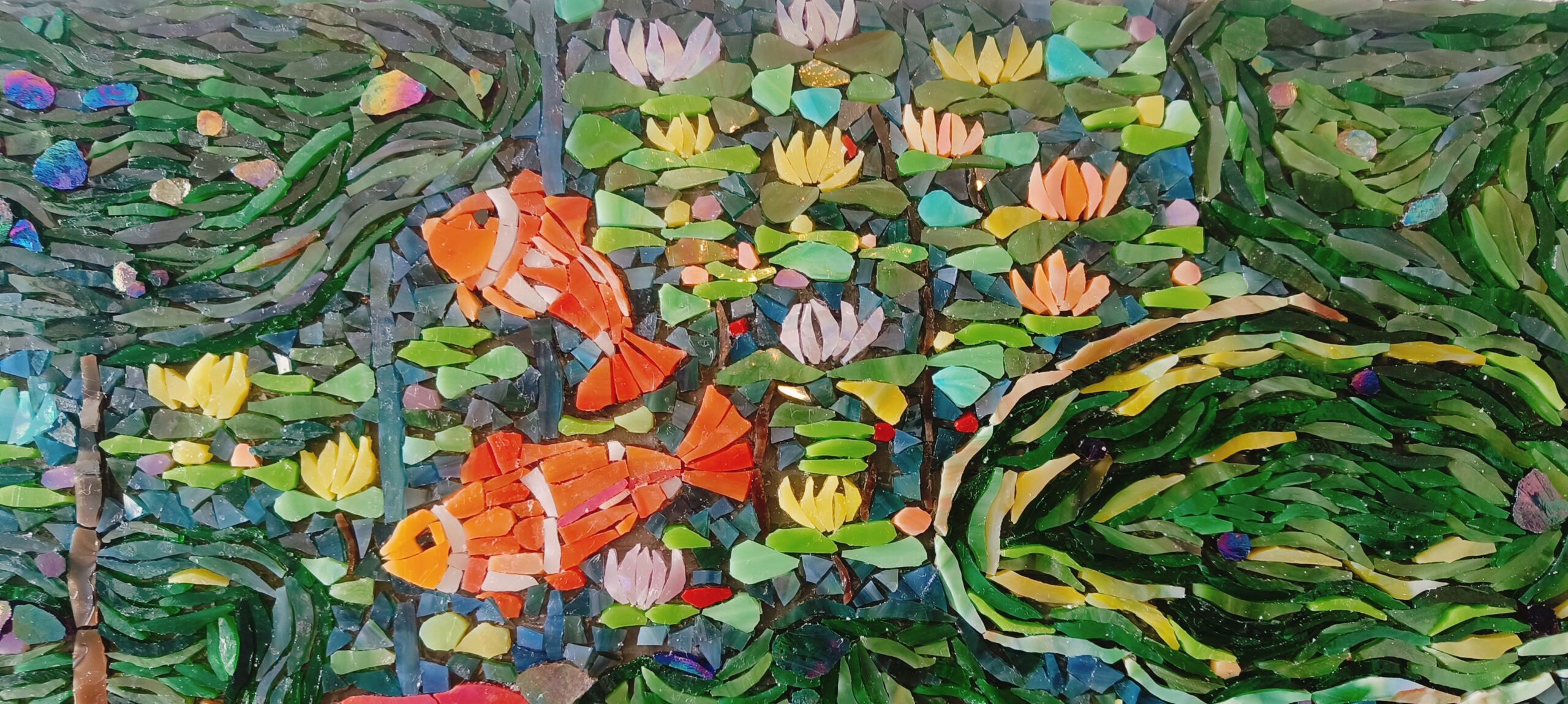Growing artist Laxmi Priya (Little Stone Mosaics) creates truly beautiful glass works using hand-cut stained glass mosaics. Her glass works demonstrate an unusually refined understanding of light and form – a sensitivity that marks her out as one of the most thoughtful voices in contemporary mosaic art. Her work includes flowers, animals, people and scenes inspired by memory creating contemporary interpretations with the minutest of details .
In creating her work, Priya uses a tactile and intuitive process that encourages her to be present and open to the creative flow. She finds inspiration in nature and sees her mosaics as a way of sharing a deeper connection with others – a connection that, in her practice, translates into luminous, deeply contemplative compositions. Her journey into mosaic art began in 2019, when stumbled upon an image of a vibrant floral mosaic. Captivated by the intricacy and vitality of the medium, she immersed herself in learning its techniques, guided by the generosity of fellow mosaic artists who shared their knowledge. Leaving behind her corporate career as an equity analyst, she embraced this artistic path, finding a profound sense of fulfillment in the quiet, meditative nature of mosaic work.
Priya begins each mosaic by studying how light reflects off the sheets of coloured glass, observing how every fragment changes tone at different times of the day. Her attention to this natural shift reveals an almost scientific curiosity about colour and perception.
She selects her palette based not only on hue but on the emotional temperature of the glass – the way cobalt can deepen into shadow or how amber seems to capture warmth within itself. This nuanced understanding of glass as both pigment and structure gives her mosaic an expressive depth rarely seen in small – scale works.
Once the composition is loosely sketched on the board, she begins cutting the glass by hand using a Glass Nipper, carefully shaping each shard until it finds its natural place within the design. For Priya, the process is both technical and meditative – an act of patience, precision, and devotion through scattered fragments are transformed into a living harmony of colour and luminosity. Her control of line and rhythm recalls classical mosaic traditions, yet her execution feels distinctly modern, freed from ornamental constraints.
The use of stained glass, and ceramics allows her to express herself in a way that is both personal and symbolic. She cuts the glass and places it into patterns that reflect her vision. For the intricate sections, Priya uses a pair of medical tweezers that belong to her mother’s home – a tool she found about a decade ago. This inherited instrument has become an extension of her hand, carrying with it a quiet sense of lineage and continuity. Each piece is fixed with a slow – setting adhesive that allows her to adjust and refine the rhythm of the arrangement.
Priya’s philosophy behind her art is based on the belief that all things are connected. Nature, emotion, memory and creativity are all linked together. When looking at her mosaics,one encounters not only imagery but sensation; the works seem to breathe with the emotions that shaped them.
Priya’s latest project is called Hope – The Living Underwater World (2025) , her largest and most ambitious to date. It measures 1200mm x 600mm and features a variety of marine creatures including koi fish, coral, water lilies and schools of fish designed entirely out of hand-cut glass pieces. The result is a composition that is not just decorative but conceptually intricate – an immersive vision that draws the viewer into an environment of layered light and symbolism.
A view of the complete framed work reveals a complexity reminiscent of large – scale environmental installations. The full composition runs vertically and simulates the density of a forest viewed under the surface of the water. Light scattering across the work animates the glass into a dynamic play of iridescent tones. The use of optical movement distinguishes Priya’s approach from many of her contemporaries; her work is less about representation than transformation – glass becoming emotion, reflection becoming memory.
The glass coral resembles flowers and stems appear like aquatic plants rising from the sea bottom. The light scattering on the surface of the work activates the iridescent glass into a dynamic flickering of colors. When viewed in person, the impact is quite immersive; you feel as if you are being drawn into the secret garden submerged in time.
Hope – The Living Underwater World, the title of the work, clearly defines its emotional foundation. Hope, for Priya, is not a great or general concept, but rather an organic process- a quiet endurance present in both nature and the creative process itself. The underwater world is metaphorically representative of resilience, interconnection and the unseen life that supports existence. Every fragment of glass represents a choice to notice, to honor, to continue on.
The thematic content of the work aligns perfectly with the ‘The Four Seasons’ exhibition Priya is participating from Sep to Nov 2025 by the Contemporary Glass Society (CGS) and Pyramid Gallery in York as a tribute to Vivaldi’s concertos. Just as Vivaldi’s movements move through cycles of growth, decay and rebirth, Priya’s mosaic captures a visual rhythmic cycle of change. The koi fish symbolize travel and continuity; the corals and lily pads represent birth and blooming. The mosaic’s surface is alive with light, creating its own type of music- silent, but pulsating with internal rhythmic activity. Her underwater world becomes a metaphor for resilience and unseen endurance, themes that recur throughout her glass practice.
Priya’s use of color is a major factor in creating this symphonic quality. She does not just use stained glass as a coloring agent, but as a collaborator – an active participant in telling her stories. Since glass has a built-in translucent property, no color is ever static; all colors will change as the light changes and as the viewer’s position changes. With her underwater compositions, the blue tones darken into shadow while the green tones radiate light from their interior, creating the feeling of observing the sun’s rays rippling on the surface of a pond. This is a dynamic quality that turns the act of looking at the mosaic into a form of contemplation.
It is Priya’s refusal to divide material from meaning that makes her distinct from many contemporary mosaic artists. To Priya, the creative process is poetic. The repetitive act of cutting and placing each tile in her mosaic is analogous to the rhythmic breathing and thinking patterns she experiences. As Priya describes the process, “it was intuitive,” she felt directed by an inner pulse rather than any external design. This meditative quality imbues each piece of hers with presence; you can almost feel the time that has gone into each piece. Few artists working in the medium manage to balance such technical control with intuitive spontaneity.
This combination of precision and intuition also positions her practice within a larger continuum of mosaic art history. Historically, mosaics have been used in sacred and public spaces including Byzantine churches and mosques. However, in Priya’s hands, the medium becomes personal, home-based and distinctly contemporary. While her pieces are not monumental, they are intimate and are meant to be experienced in a home setting rather than a place to look upon. She chooses to use tile insulation backer boards and mesh as the base for her pieces; a practical and modern choice that highlights her independence from historical precedents.
Priya is a professional member of International Mosaic Organizations like the British Association for Modern Mosaic (BAMM), The Contemporary Glass Society (CGS), Contemporary Mosaic Art 2 (CMA2),and Mosaic Association of Australia and New Zealand (MAANZ) and also mosaic groups – Mosaic India and Mosaic Mentoring. These associations allow her to hone her skills as well as connect with other artists around the world. However, Priya’s voice is always unique and recognizable. At a time when digital perfection dominates over craftsmanship, Priya’s mosaics illustrate the importance of physical contact- the human, imperfect gesture that lends substance to light.
One of the most powerful aspects of Priya’s work is the emotionally realistic context of that work. The images come from the natural world, but they are not simply representational. The glass fish, the corals, the lilies in Hope – The Living Underwater World, become symbols of emotion: movement becomes longing, blossomings signify new beginnings, water signifies memory. The glass surface becomes a symbol of the thin wall which separates two realms from each other, the visible from the invisible, the conscious from the unconscious. Viewing the finished mosaic, full of the warm wood frame which contrasts with its glories of luminous iridescence, gives an impression that the mosaic is alive. The glass absorbs the light of the day, gives it out again to the space as a soft reflection on the adjacent walls. The space of the mosaic metamorphoses itself from that of an object to that of an environment. The spectator no longer finds himself out-side the picture, rather he becomes a part of it, immersed in its calm natural cycle of light and colour.
Ultimately, Hope – The Living Underwater World is more than a mosaic-it is a reflection on resilience. The beauty of this mosaic lies in both its composition and the time and devotion that went into creating it. Each fragment of glass bears the mark of human contact and the passage of time. Working together, these fragments create an image that shines with life, reminding us that hope, like light, is never static- it moves, breaks, and returns, quietly and constantly, through the things we chose to see.
Hope – The Living Underwater world glass mosaic is on display at Pyramid Gallery, 43 Stonegate, York from September to November 2025.
More of Priya’s glass works can be seen in her Facebook and Instagram page, named ‘Little Stone Mosaics’.
Instagram link to Little Stone Mosaics : https://www.instagram.com/littlestonemosaics/
Facebook link to Little Stone Mosaics: https://www.facebook.com/littlestonemosaics/
Link for CGS – Pyramid Gallery exhibition from Sep to Nov 2025: https://www.pyramidgallery.com/the-four-seasons-exhibition-of-glass-by-cgs/#theshow1




